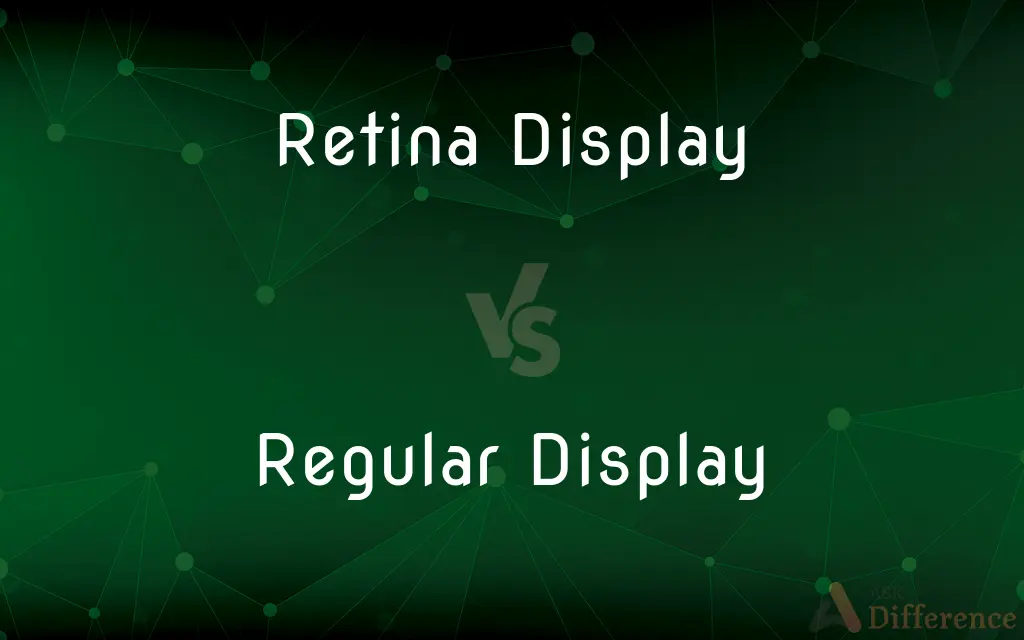Retina Display vs. Regular Display — What's the Difference?
By Tayyaba Rehman — Published on December 4, 2023
Retina Display offers higher pixel density for sharper images; Regular Display has standard resolution.

Difference Between Retina Display and Regular Display
Table of Contents
ADVERTISEMENT
Key Differences
Retina Display, coined by Apple, refers to screens with a resolution so high that the human eye cannot discern individual pixels at a typical viewing distance. The primary objective behind the development of Retina Display was to enhance the sharpness and clarity of on-screen content. On the contrary, a Regular Display, as the term suggests, adheres to standard resolution metrics, often resulting in visible pixels when observed closely.
The advantage of Retina Display is evident in the rendering of text, images, and videos. Characters appear smoother, images more detailed, and colors more vibrant. This is due to the densely packed pixels, which reduce the space between them. In contrast, a Regular Display might not offer the same level of clarity, especially on larger screens where pixel density isn't as high, causing potential pixelation.
It's essential to understand that Retina Display isn't a standardized term. It's a brand-specific term introduced by Apple, and what qualifies as "Retina" may vary between devices based on screen size and viewing distance. A Regular Display, on the other hand, covers a broad spectrum of screens without any such proprietary benchmarks, spanning from low to high resolutions.
Cost implications are also tied to these display types. Retina Displays, given their advanced technology and higher pixel count, tend to be more expensive than their Regular Display counterparts. When deciding between a Retina Display and a Regular Display, consumers often weigh the enhanced visual experience against the price point.
However, the distinction between Retina Display and Regular Display is becoming less pronounced as technology evolves. Many non-Apple manufacturers now produce screens with comparable pixel densities, blurring the line between what's considered "regular" and what might be deemed "retina" quality.
ADVERTISEMENT
Comparison Chart
Pixel Density
Higher pixel density for sharper images.
Standard pixel density.
Visibility of Pixels
Pixels not discernible at typical viewing distance.
Pixels may be visible up close.
Brand Association
Term introduced by Apple.
Generic term used universally.
Cost Implication
Typically more expensive.
Generally more affordable.
Clarity and Vibrancy
Enhanced sharpness and color vibrancy.
Standard clarity and color vibrancy.
Compare with Definitions
Retina Display
Retina Display is a high-resolution screen technology by Apple.
My iPhone's Retina Display makes photos look incredibly sharp.
Regular Display
Regular Display offers standard clarity and color vibrancy.
While my tablet has a Regular Display, the colors are still quite vibrant.
Retina Display
Retina Display ensures individual pixels are indistinguishable at usual viewing distances.
I can't see any pixelation on my iPad's Retina Display.
Regular Display
Regular Display may show pixelation when observed closely.
When I zoom in on my Regular Display, I can see the pixels.
Retina Display
Retina Display is Apple's trademark for its high-definition screens.
The latest Apple monitor boasts a larger Retina Display.
Regular Display
Regular Display covers a broad range of resolutions without specific proprietary benchmarks.
The TV in my living room has a Regular Display, suitable for casual viewing.
Retina Display
Retina Display offers superior clarity due to high pixel density.
Graphics come to life on the MacBook's Retina Display.
Regular Display
Regular Display refers to standard resolution screens without enhanced pixel density.
My old laptop has a Regular Display, but it works just fine.
Retina Display
Retina Display enhances user experience with crisper visuals.
Watching movies on a Retina Display is a treat for the eyes.
Regular Display
Regular Display is typically more affordable than high-resolution counterparts.
I chose a Regular Display for my office computer to save on costs.
Common Curiosities
What is the main benefit of Retina Display?
Retina Display offers sharper, clearer visuals due to its higher pixel density.
Can I see individual pixels on a Regular Display?
On a Regular Display, pixels may be visible when observed closely.
Are all new devices equipped with Retina Display?
No, the choice between Retina Display and Regular Display often depends on the device's purpose and price point.
Is Retina Display exclusive to Apple products?
The term "Retina Display" is an Apple trademark, but many non-Apple screens now have comparable pixel densities.
Can I upgrade my Regular Display to a Retina Display?
Upgrading involves changing the screen, which may not be feasible or cost-effective for all devices.
Does Retina Display consume more battery?
While Retina Displays can consume more power, advancements in technology often offset this with efficient battery use.
Is the visual difference between Retina Display and Regular Display always noticeable?
The difference is more pronounced when viewing high-resolution content and varies by individual perception.
How does Retina Display affect gaming?
Retina Display offers crisper graphics, enhancing the gaming experience.
Is there a significant price difference between Retina Display and Regular Display devices?
Retina Display devices tend to be pricier due to the advanced screen technology.
Do non-Apple brands have a term equivalent to Retina Display?
While many brands offer high-resolution screens, "Retina Display" is specific to Apple.
Does Regular Display mean low quality?
No, Regular Display offers standard resolution; quality varies based on the device and manufacturer.
Are there drawbacks to Retina Display?
Some users may notice increased battery consumption, and the devices might be pricier.
Share Your Discovery

Previous Comparison
Gross Total Income vs. Total Income
Next Comparison
Liquidated Damages vs. Unliquidated DamagesAuthor Spotlight
Written by
Tayyaba RehmanTayyaba Rehman is a distinguished writer, currently serving as a primary contributor to askdifference.com. As a researcher in semantics and etymology, Tayyaba's passion for the complexity of languages and their distinctions has found a perfect home on the platform. Tayyaba delves into the intricacies of language, distinguishing between commonly confused words and phrases, thereby providing clarity for readers worldwide.
















































